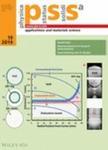版权所有:内蒙古大学图书馆 技术提供:维普资讯• 智图
内蒙古自治区呼和浩特市赛罕区大学西街235号 邮编: 010021

作者机构:Naruto Univ Educ 748 NakashimaNaruto Cho Naruto Tokushima 7728502 Japan Keio Univ Fac Sci & Technol Kohoku Ku 3-14-1 Hiyoshi Yokohama Kanagawa 2238522 Japan Japan Atom Energy Agcy 801-1 Mukouyama Naka Ibaraki 3190913 Japan
出 版 物:《REVIEW OF SCIENTIFIC INSTRUMENTS》 (科学仪器评论)
年 卷 期:2016年第87卷第2期
页 面:02B124-02B124页
核心收录:
学科分类:08[工学] 080401[工学-精密仪器及机械] 0804[工学-仪器科学与技术] 081102[工学-检测技术与自动化装置] 0811[工学-控制科学与工程] 0702[理学-物理学]
基 金:Grants-in-Aid for Scientific Research [26400533 15H04232] Funding Source: KAKEN
主 题:Particle-in-cell method Halo Negative ion beams Magnetic fields Negative ion sources
摘 要:The physical mechanism of the formation of the negative ion beam halo and the heat loads of the multi-stage acceleration grids are investigated with the 3D PIC (particle in cell) simulation. The following physical mechanism of the beam halo formation is verified: The beam core and the halo consist of the negative ions extracted from the center and the periphery of the meniscus, respectively. This difference of negative ion extraction location results in a geometrical aberration. Furthermore, it is shown that the heat loads on the first acceleration grid and the second acceleration grid are quantitatively improved compared with those for the 2D PIC simulation result. (C) 2015 AIP Publishing LLC.